Ever feel like getting quality leads is harder than convincing your dog not to bark during Zoom calls?
You’re not alone.
A whopping 61% of marketers say lead generation is their number one challenge, and honestly, it’s easy to see why.
Algorithms shift, inboxes overflow, and audiences? They’ve got shorter attention spans than ever.
But here’s the good news: understanding the latest lead generation statistics can flip the script. You’ll spot what’s working right now, what’s flopping, and where the biggest opportunities are hiding.
And just so you know, every stat you’ll see here is verified. I’ve included a complete list of sources at the end of the article for complete transparency.
Let’s break it all down.
🔑 Key Lead Generation Statistics:
1. 50% of marketers consider lead generation a top priority in their marketing campaigns.
(HubSpot)
Half of all marketers are putting lead generation front and center in their campaigns.
Why? Because without leads, there’s no pipeline. And without a pipeline, there’s no revenue. And, if you’re not treating lead gen like a top priority, you’re already a step behind.
This stat serves as a reminder that capturing attention and converting it into action is the real game.
2. 61% of marketers say lead generation is their number one challenge.
(HubSpot)

It’s a clear signal that even with all the tools, platforms, and strategies available, actually getting qualified leads isn’t easy.
You might be running ads, publishing content, or building funnels, but if they’re not bringing in the right people, it feels like spinning wheels.
This stat shows you’re not alone. Lead generation remains a significant challenge for most marketers, and resolving it is often the difference between growth and stagnation.
3. On average, organizations pull in 1,877 leads per month, and 4 out of 5 are considered MQLs.
(HubSpot)
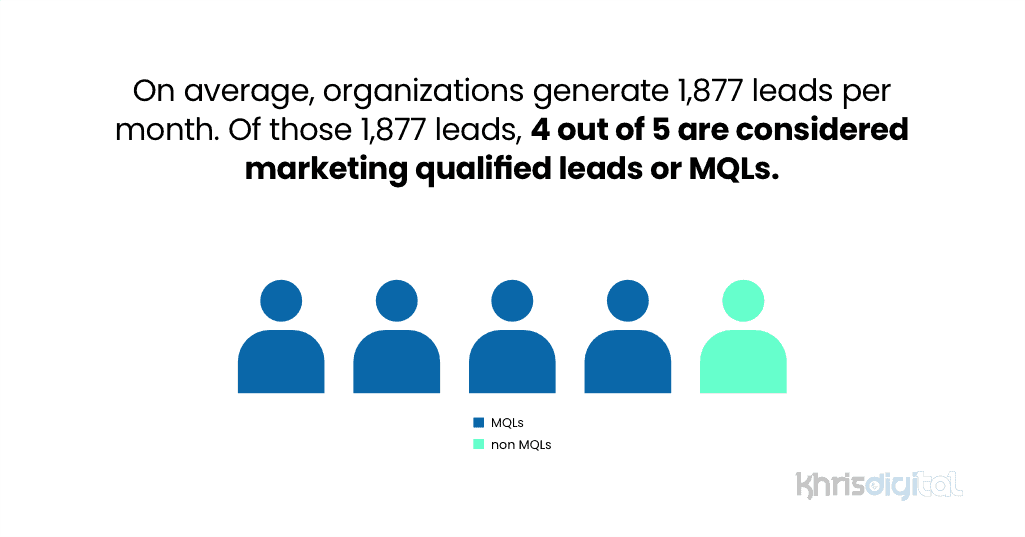
That’s a solid volume, but the real takeaway is the quality.
If 80% of those leads are marketing qualified, it means the targeting, messaging, and channels are hitting the right audience.
For you, this sets a benchmark. It’s not only about how many leads you’re generating, it’s about how many are actually worth nurturing. Volume means little if quality doesn’t follow.
4. B2B advertising and marketing spend in the U.S. hit $59.5 billion in 2024, and it’s on track to top $69 billion by 2026.
(Statista)
That’s nearly a $10 billion jump in just two years. For you, it means one thing: the competition is heating up.
More money in the market means more content, more ads, and more noise. If you’re not getting sharper with your lead generation strategy, you risk getting drowned out. Budget alone won’t win leads, but precision will.
5. U.S. online B2B advertising and marketing spend reached $20.4 billion in 2024 and is expected to jump to $27 billion by 2026.
(Statista)
That’s a $6.6 billion increase in just two years, all going into digital channels.
For you, that means more competition across search, social, and programmatic. If you’re relying on the same old playbook, it might not cut through anymore. As budgets grow, so does the need for smarter, more targeted lead gen strategies.
6. The global B2B lead generation services market is projected to grow from $2.4 billion in 2023 to $6.5 billion by 2032, at an annual growth rate of 11.8%.
(Data Intelo)
That kind of sustained growth shows just how valuable outsourced lead gen has become.
If you’re not seeing results in-house, you’re not alone. Many businesses are turning to specialized providers to fill the gap. It’s no longer just about doing it yourself; it’s about doing it right, even if that means bringing in help.
7. 12% of marketers admit they don’t know how many leads they’re generating.
(HubSpot)
That might not sound like much, until you realize it means no tracking, no benchmarks, and no clear ROI.
If you’re in that 12%, you’re basically flying blind. Without precise numbers, there’s no way to know what’s working or where to improve. Lead generation starts with measurement, everything else comes after.
8. 70% of marketers rate their leads as “high quality.”
(HubSpot)
That’s a promising sign. But it also raises a question: how are they measuring quality?
If you’re seeing leads that convert, engage, and actually fit your ideal customer profile, that’s great. But if “high quality” means they filled out a form, you might be giving your pipeline more credit than it deserves.
It’s worth checking how you define and score your leads, because quality only matters if it leads to revenue.
9. The average cost per lead across all industries is $198.44.
(HubSpot)
That’s a serious investment for a single potential customer. If your leads aren’t converting, that money burns fast.
This number gives you a benchmark and a warning.
If you’re spending more, it better be worth it. If you’re spending less, make sure quality isn’t suffering. Either way, tracking your true CPL is key to knowing if your lead gen is actually sustainable.
10. 9% of organizations pay $10 or less per lead, while 4% spend $1,000 or more.
(HubSpot)
That’s a huge gap, and it shows how differently businesses value leads. For some, cheap volume works. For others, a single high-ticket lead justifies the cost.
Where you fall depends on your industry and offer. The key isn’t spending the least or the most, it’s spending the right amount for leads that actually convert.
11. 18% of marketers don’t know their cost per lead.
(HubSpot)
That’s nearly one in five running campaigns without tracking one of the most critical numbers in marketing.
If you’re in that group, it’s like buying ads with a blindfold on. You’ll never know if you’re overpaying or underperforming. CPL isn’t just a metric; it’s the baseline for judging whether your lead gen strategy is worth the spend.
12. When asked about their top priority for the next 12 months, 34% of marketers chose lead generation.
(HubSpot)

It outranked increasing customer satisfaction (22%), building brand awareness (19%), and even closing more deals (14%).
That says a lot.
For most marketers, everything starts with leads. Because without a steady flow of prospects, there’s nothing to nurture, nothing to sell, and nothing to grow. Lead gen is the foundation the rest of marketing depends on.
13. 63% of leads who inquire about your business won’t convert for at least three months.
(Marketing Donut)
That delay can feel frustrating, but it’s the reality of most buying cycles. Just because someone shows interest today doesn’t mean they’re ready to buy tomorrow.
For you, this stat is a reminder that nurturing matters.
If you drop the conversation too soon, you risk losing leads that simply need more time. Patience, consistent follow-up, and value-driven communication are what turn early interest into future customers.
14. IT and services organizations generate an average of 3,660 leads per month, more leads per month than any other industry.
(HubSpot)
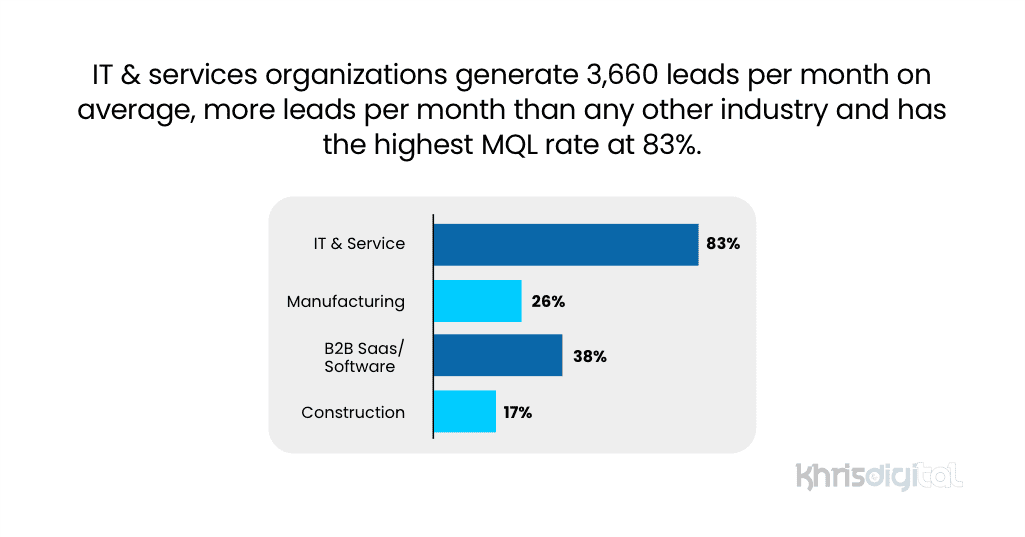
That volume shows just how aggressive and competitive the sector is when it comes to filling the pipeline.
If you’re in IT or services, the benchmark is high. And if you’re outside it, the lesson is clear: scale matters, but only if those leads are qualified. Chasing numbers without matching quality is just busy work.
15. IT and services organizations hold the highest MQL rate at 83%.
(HubSpot)
That means more than four out of five of their leads are marketing qualified. It’s more than pulling in significant numbers; it’s about targeting the right audience from the start.
For you, this stat highlights the value of strong positioning and precise targeting. When the message hits the right market, qualification becomes the rule, not the exception.
16. Non-profits generate the fewest leads, averaging just 600 per month.
That’s a sharp contrast to industries like IT and services, where lead numbers soar into the thousands.
For non-profits, the challenge is more than just raising awareness. It’s attracting the right supporters, donors, or volunteers with limited budgets. This stat shows that volume isn’t always the goal.
For mission-driven organizations, the focus is on establishing quality connections that lead to long-term support.
17. Outbound leads cost 39% more than inbound leads.
(Copilot AI)

Cold calls, direct outreach, and purchased lists take more effort, and they also hit your budget harder.
Inbound leads, on the other hand, come from people already interested in what you offer, which makes them cheaper and usually warmer. For you, this is a push to invest more in content, SEO, and campaigns that attract leads naturally.
Paying extra for outbound only makes sense if the return justifies it.
18. 95% of marketers believe they know which channel drives the most leads.
(Ruler Analytics)
Confidence is high, but belief doesn’t always equal accuracy. If you’re not tracking data properly, assumptions can easily skew strategy.
You may think social is your strongest channel, but analytics might show email or organic search doing the heavy lifting.
This is a reminder that gut feelings aren’t enough. You need hard numbers to know where your best leads are really coming from.
19. The top three B2B lead generation strategies are email marketing (78%), event marketing (73%), and content marketing (67%).
(Cleverly)
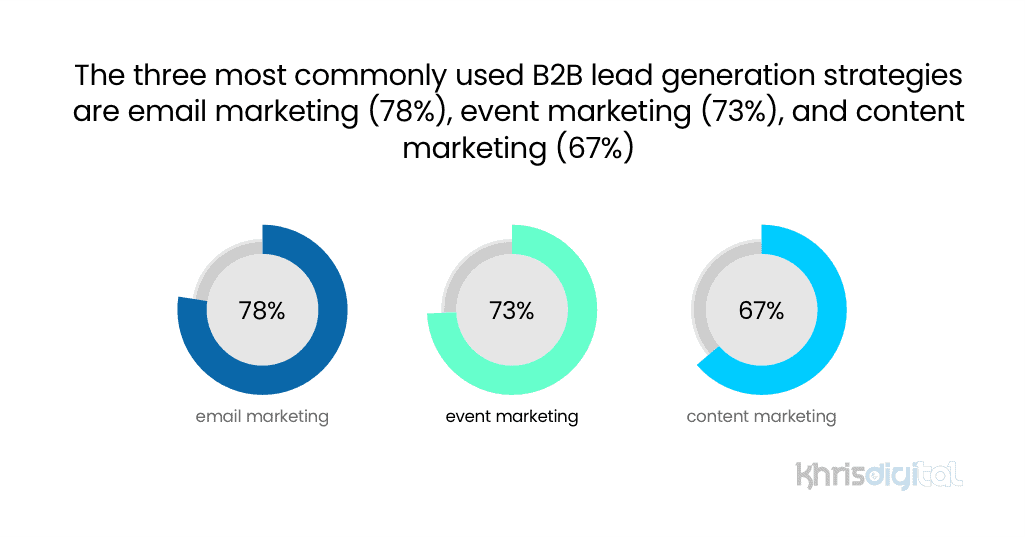
Email remains the backbone of nurturing, events create direct connections, and content builds long-term trust.
If you’re running B2B campaigns, this shows where most of your peers are focusing their energy.
The question for you is whether you’re using these marketing channels effectively, or just checking boxes. Execution, not just presence, is what makes these strategies work.
20. 27% of marketers say organic search brings in the most leads.
(Ruler Analytics)
That makes SEO the top lead source for over a quarter of marketers. It makes sense, as people searching are already showing intent, which means they are more likely to be higher-quality leads.
For you, this stat shows the value of ranking well. Paid ads can be turned off, but strong organic visibility compounds over time and keeps delivering leads without the constant spend.
21. 97% of people ignore cold calls.
(Business Wire)
That means for every 100 dials, only a handful might even pick up, and fewer still will listen.
For you, this stat is a reality check: the old outbound approach is losing ground fast. Buyers don’t want interruptions; they want value on their terms.
If cold calling is still part of your strategy, it’s time to rethink how much effort you’re putting into a channel that almost everyone is tuning out.
22. 76% of content marketers use content to generate leads.
(YouGov)
Blogs, guides, webinars, and case studies are built to capture interest and move people closer to a decision.
If you’re not using content with lead generation in mind, you’re missing out on what three-quarters of marketers already rely on. The right content doesn’t just educate; it attracts the right audience and opens the door for conversions.
23. Lead generation ranks as the third most important metric for measuring content marketing success.
(HubSpot)
Views and engagement might show reach, but leads prove impact.
If your content isn’t driving sign-ups, inquiries, or qualified contacts, it’s not doing its whole job. Tracking leads alongside other metrics gives you a clearer picture of what’s really working.
24. Content marketing delivers across the funnel.
(HubSpot)

According to marketers, 74% say it helps generate demand and leads, 62% say it nurtures audiences, and 52% see it growing loyalty with existing customers.
Nearly half (49%) even credit it with driving sales and revenue. Beyond that, 37% say it builds a subscribed audience, while 9% report reduced support costs.
For you, the takeaway is simple: content isn’t just top-of-funnel fluff. Done right, it works at every stage, from attracting new prospects to keeping current customers engaged.
25. Content marketing generates three times more prospects than outbound marketing, while costing 62% less.
(Search Engine Journal)
That’s the kind of efficiency every marketer wants. Instead of pushing messages out and hoping they land, content pulls the right people in at a fraction of the cost.
If you’re still relying heavily on outbound, you’re paying more for fewer results. Shifting resources toward content can mean higher-quality leads and better ROI.
26. Content marketing shines in the early stages of the buyer’s journey.
(Content Marketing Institute)
When prospects are researching, comparing, and just starting to explore options, content is what gets you noticed.
Blogs, guides, and videos answer their questions and position you as a trusted source before they’re even ready to buy. The leads you capture with helpful content now are the ones who’ll remember you when it’s time to make a decision.
27. 45% of content marketers say their biggest challenge is attracting quality leads.
(SEMrush)
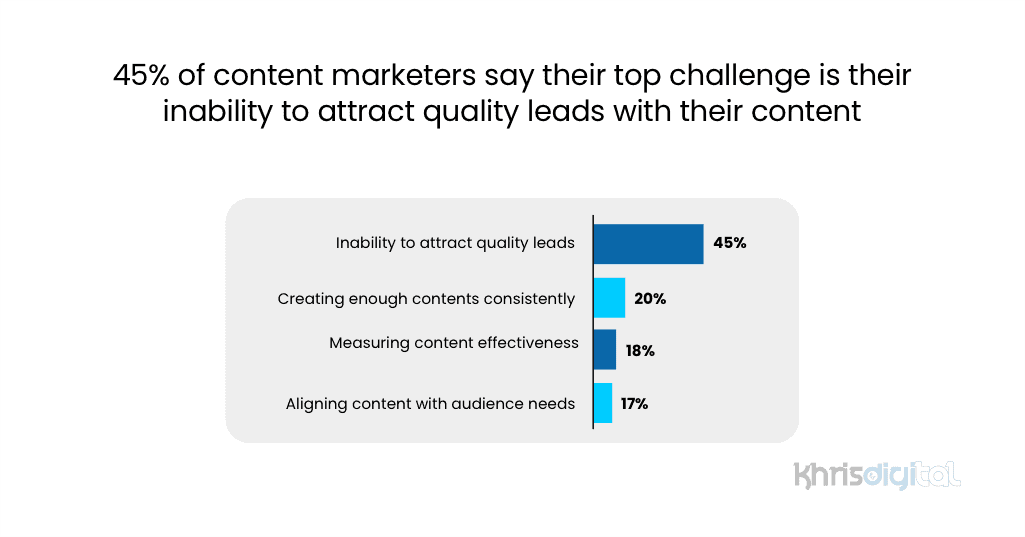
Publishing content is easy, but bringing in the right audience is the hard part. If you’re writing blog posts that drive clicks but not conversions, you’re not alone.
This stat shows that nearly half of marketers struggle to align content with the needs of qualified buyers.
For you, it’s a push to focus less on volume and more on precision: content that speaks directly to the people most likely to become customers.
28. 85% of B2B marketers use content to generate leads, compared to 60% of B2C marketers.
(YouGov)
The gap makes sense as B2B buyers often need more education before making a decision, and content provides that depth.
Content is essential in B2B. It builds trust, answers complex questions, and nurtures longer sales cycles. In B2C, the path to purchase is often shorter, but in B2B, content is a core lead gen driver.
29. 93% of B2B companies say content marketing generates more leads than traditional marketing.
(Forbes)
That’s nearly universal agreement, and it’s not hard to see why.
Cold calls, print ads, and trade shows can’t match the reach, precision, and cost-effectiveness of digital content. If you’re still leaning heavily on traditional methods, you’re competing against a channel most of your peers already trust more.
30. B2B companies that blog generate 67% more leads than those that don’t.
(HubSpot)
Blogging may feel old-school, but it works.
Every post is a new chance to get found, answer buyer questions, and build trust before a sales call ever happens. Skipping blogging means leaving potential leads on the table.
31. 70% of B2B marketers say video outperforms other content for converting users into qualified leads.
(Gitnux)
Video grabs attention, simplifies complex ideas, and builds trust faster than text alone.
In B2B, where decisions can be technical and high-stakes, that personal, visual connection matters. For you, this stat is a push to think beyond blogs and whitepapers.
32. 46% of marketers rank affiliate and partner marketing as the top channel for lead gen ROI, followed by paid ads (43%) and email (34%).
(Affiliate Summit)

That ranking flips the script a bit. While email and ads get most of the attention, partnerships are quietly delivering the best returns.
The right partners already have access to your audience, and tapping into that network can outperform even your strongest in-house campaigns.
33. 99% of marketers agree that webinars are key to lead generation.
(ON24)
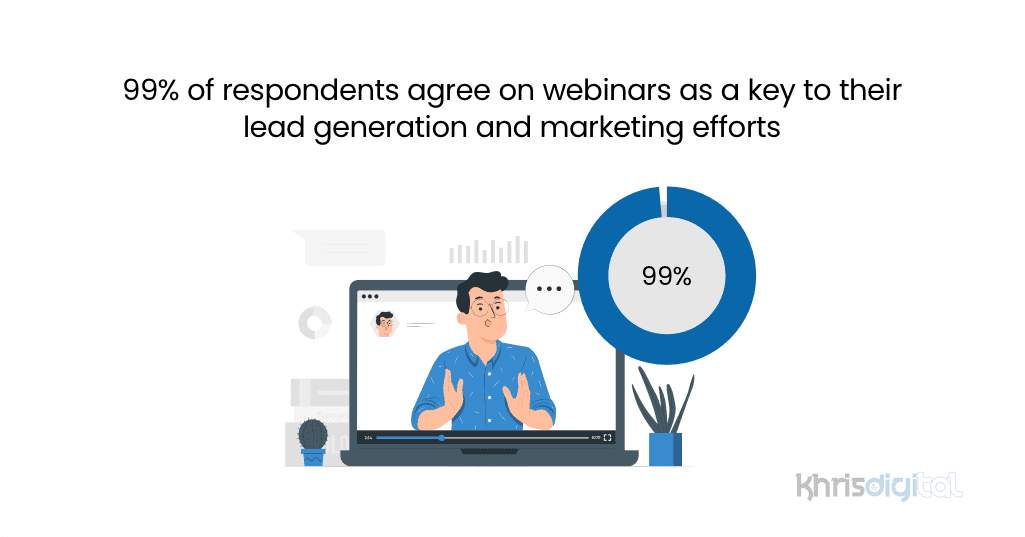
Such a consensus is rare, but it demonstrates the power of webinars in attracting and qualifying prospects.
They combine education with interaction, letting you showcase expertise while building trust in real time. This indicates that webinars are almost universally incorporated into B2B lead strategies.
34. 75% of marketers use them to build their brand, and 76% say they generate more leads with them.
(ON24)
That’s the beauty of webinars. They raise awareness and fill the pipeline at the same time.
Done right, they work across the funnel, creating trust while capturing qualified leads who’ve already invested time in your message.
35. 73% of sales leaders and B2B marketers agree that webinars are a great way to generate leads.
(HubSpot)
That alignment matters because marketing and sales don’t always see eye to eye. When both sides back webinars, it shows they’re a real driver of the pipeline.
This is proof that webinars help bridge the gap between awareness and sales conversations, making them one of the few tactics both teams can fully get behind.
36. 45% of B2B marketers say webinars are their most effective top-of-funnel demand gen channel.
(MarketingCharts)
That makes sense because at the awareness stage, prospects want education, not a sales pitch.
Webinars deliver value up front while giving you a chance to capture leads early. They work best when used to open doors, build trust, and set the stage for deeper conversations later.
37. 60% of webinars are designed to turn leads into loyal customers.
(Your Target)
This shows webinars are more than a top-of-funnel tactic, they’re also a tool for retention and long-term growth.
Lead generation doesn’t stop at capturing names. The real win is building loyalty, and webinars give you a platform to educate, support, and strengthen relationships with the people already in your pipeline.
38. Lead generation takes a big slice of digital marketing budgets.
(Affiliate Summit)

More than half of businesses put at least 40% of their spend into it, while 28% dedicate 60% or more. And interestingly, not a single company reports spending below 10%.
This shows how central lead gen is to digital strategy. It’s not an afterthought; it’s where the majority of resources go because, without leads, the rest of the funnel never gets filled.
39. Websites with 401–1,000 pages generate six times more leads than those with just 51–100 pages.
(Cleverly)
The reason is simple: more pages mean more chances to rank, more opportunities to answer questions, and more touchpoints for capturing interest.
A handful of landing pages isn’t enough. A content-rich site builds authority and drives a steady flow of leads.
40. Around 80% of B2B marketers use marketing automation for lead generation.
(Apsis One)
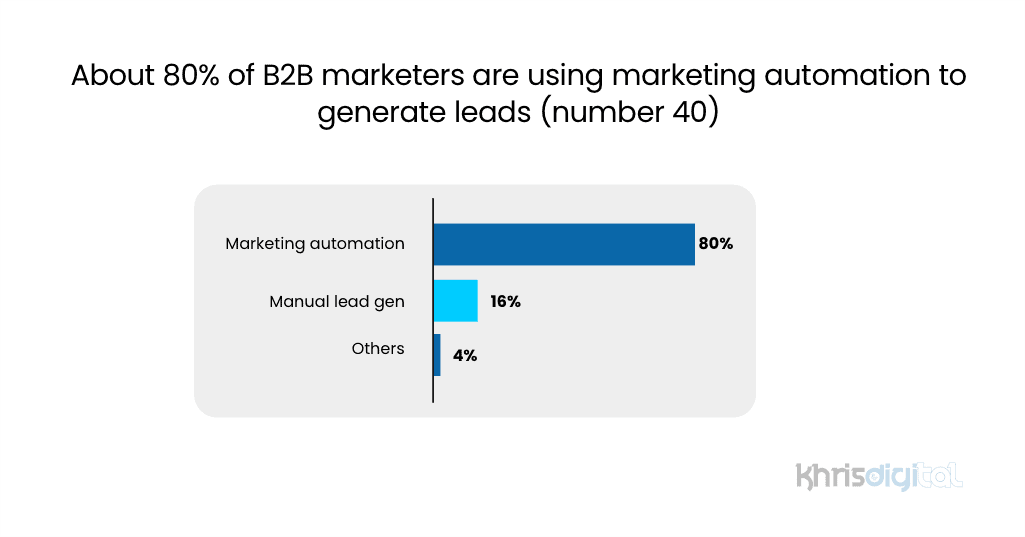
Automation takes care of the repetitive work, like follow-up emails, lead scoring, and nurturing, so you can focus on strategy and sales.
If you’re still handling everything manually, you’re already behind most of your competitors who are scaling their lead gen with smart, automated systems.
41. 85% of B2B marketers say lead generation is their top content marketing goal.
(Cleverly)
It outranks brand awareness, engagement, or even customer education.
Content isn’t created just to be read or shared; it’s built to capture leads. Every blog, whitepaper, or webinar should tie back to the bigger goal of filling the pipeline. Without that focus, content risks becoming busy work instead of a growth driver.
42. 54% of content marketers say early-stage content delivers the most value.
(Content Marketing Institute)
At the awareness stage, prospects are just starting to look for answers, and helpful content gets you on their radar.
Content, such as educational blogs, guides, and resources, that sparks interest before the sales pitch even begins is essential. Building trust early creates momentum that carries leads further down the funnel.
43. Just 8% of content marketers see “ready-to-buy” content as the most valuable.
(Content Marketing Institute)
That’s because by the time a prospect is purchase-ready, most of the decision-making is already done.
The bigger opportunity lies in earlier stages, where education, trust, and credibility shape who makes it to the buying table in the first place.
44. Podcasts, blog posts, and videos rank as the top three content types for generating awareness and demand.
(Content Marketing Institute)
Each plays a different role. Blogs fuel search visibility, videos grab attention fast, and podcasts build deeper connections over time.
For you, this stat is a reminder to diversify your content mix. Sticking to just one format limits your reach, but combining them helps you meet prospects wherever they prefer to learn and engage.
45. Podcasts top the list for moving leads from awareness to consideration, with 77% of marketers backing them.
(Content Marketing Institute)

Blog posts and articles follow closely at 76%, while 59% point to video as effective.
This suggests that more in-depth, engaging formats, such as podcasts and long-form written content, play a significant role in helping prospects evaluate their options. Video still matters, but when it comes to nurturing, content that allows for more detail and storytelling often has the edge.
46. Companies that nurture leads see 50% more sales at 33% lower costs.
(WooSuite)
The math is simple: staying in touch pays off. When you nurture, you’re not just reminding leads you exist; you’re building trust and guiding them toward the right decision.
The follow-up is where efficiency and revenue really take shape. Skipping nurturing is like planting seeds and never watering them.
47. Nurtured leads create 20% more sales opportunities than non-nurtured leads.
(HubSpot)
It’s a clear signal that steady follow-up and personalized touchpoints make a measurable difference.
For you, this stat reinforces the idea that capturing a lead is just the beginning. The real growth comes from nurturing and keeping leads engaged until they’re ready to move forward.
48. Nurtured leads spend 47% more than non-nurtured leads.
(Annuitas)
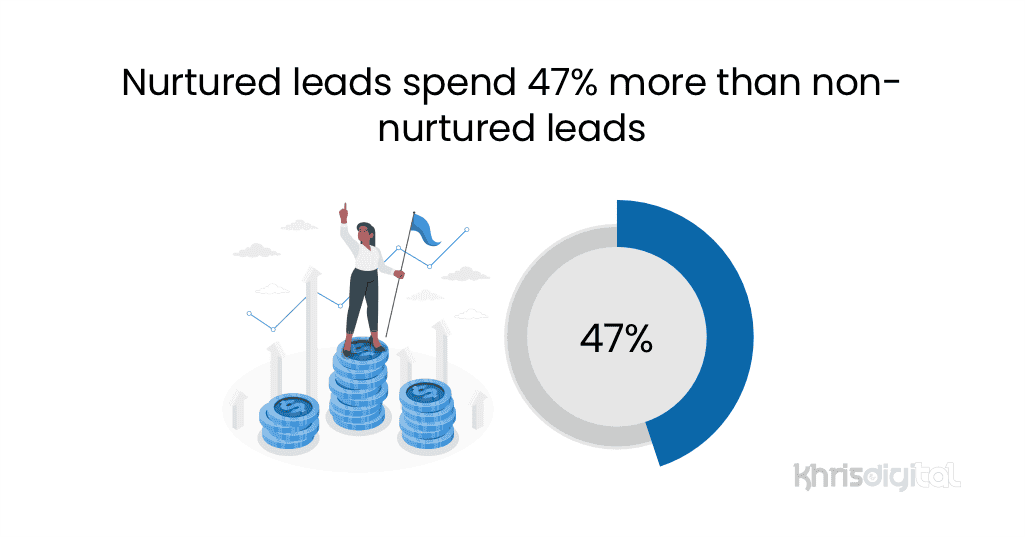
Consistent nurturing builds trust, and trust leads to higher-value purchases.
It directly impacts revenue per customer, making it one of the most profitable parts of the lead generation process.
49. Leads are 21x more likely to convert if you follow up within five minutes.
(Revenue Hero)
Speed is everything. The longer you wait, the colder the lead gets.
Whether it’s a call, an email, or even an automated message, fast follow-up shows prospects you’re serious and keeps their interest alive. Miss that window, and you risk losing them to a competitor who moved faster.
50. Lead-nurturing emails generate 4–10 times the response rate of standalone emails.
(Invesp)
That’s because they’re part of a bigger conversation, not a one-off pitch.
When emails build on each other and guide leads step by step, people are far more likely to engage. A single email can be ignored, but a thoughtful sequence keeps you on the radar until the timing is right.
51. Only about 1 in 5 marketing emails gets opened.
(Campaign Monitor)
That’s a 20% open rate, meaning most of your messages never even get seen.
This is a reminder that subject lines, timing, and list quality matter as much as the content itself. If your emails aren’t getting opened, they’re not generating leads. The goal is to send smarter.
52. Email open rates vary widely by industry, from 17.1% in retail to 28.5% in education.
(Campaign Monitor)
The gap shows how audience type and messaging style influence engagement.
A “good” open rate in retail might look weak in education, and vice versa. Context is everything when judging whether your email strategy is working.
53. Email open rates are rising, but click-to-open rates are falling year over year.
(Campaign Monitor)
More people are checking messages, but fewer are taking the next step.
Subject lines may get attention, but if the content inside doesn’t drive clicks, the lead gen impact is lost. It’s not enough to win the open; you need to deliver value that earns action.
54. Marketing emails see better performance when sent on Monday, Tuesday, or Wednesday.
(Campaign Monitor)
Timing matters as much as content. Midweek timing tends to catch people when they’re most engaged with work and more likely to check messages.
A strong email sent at the wrong time can get buried, while a well-timed send has a better shot at grabbing attention and driving leads.
55. Email performance peaks early in the week.
(Campaign Monitor)
Mondays see the highest open rates at 22%, while Tuesdays drive the strongest click-throughs at 2.4%. Click-to-open rates hit their high point on Tuesdays and Wednesdays at 10.8%.
If you’re blasting emails on Fridays or weekends, you’re likely missing your audience when they’re most responsive.
56. Cold email outreach sees an average reply rate of just 8–10%.
That means nine out of ten messages go unanswered.
If you’re sending cold emails, personalization and relevance are the only ways to stand out in a crowded inbox. Otherwise, most of your efforts will get ignored.
57. Less than half of online shoppers open branded emails daily.
(Digital Commerce 360)
That means even your most engaged audience isn’t checking in every day.
Bombarding inboxes won’t guarantee attention; it’s the quality of the message that gets people to open when they do check. Consistency matters, but so does restraint.
58. Email marketing drives action, but frequency varies.
(Digital Commerce 360)
In a survey of 1,015 online shoppers, 60% said marketing emails lead them to make at least one purchase per month. Only 10% buy weekly, while 22% say they never purchase from emails.
This shows email can be a steady revenue driver, but not every subscriber will convert at the same pace. The key is segmenting your list and tailoring frequency and offers to match different buying habits.
59. 68% of marketers say social media helps them generate more leads.
(Social Media Examiner)
Platforms like LinkedIn, Instagram, and Facebook are active lead pipelines.
For you, this stat is a reminder that social isn’t just about likes or followers. With the proper targeting and content, it can bring qualified prospects straight into your funnel.
60. Experience matters in social media lead generation.
(Social Media Examiner)
While 72% of marketers with five or more years under their belt say social drives leads, only 42% of newcomers agree.
This stat shows that success on social takes time, from learning the platforms to refining content and targeting. If you’re not seeing results yet, it may be less about the channel and more about experience with using it effectively.
61. One in four social media marketers list lead generation as their top learning priority.
(Social Media Examiner)
It’s a sign that while social is powerful, many are still figuring out how to use it for more than brand awareness. Turning likes and follows into leads takes strategy, and it’s a skill worth sharpening if you want social to drive real business growth.
62. LinkedIn leads the pack for B2B lead generation, with 44% of marketers naming it their top platform.
(Social Media Examiner)
The professional focus, targeting options, and presence of decision-makers make it a natural fit for B2B outreach.
If you’re chasing B2B leads anywhere else first, you may be overlooking the platform built for precisely that purpose.
63. LinkedIn is getting even more attention from B2B marketers.
(Social Media Examiner)
About 72% plan to ramp up their organic efforts to drive traffic and leads, while 52% want to learn more about LinkedIn ads.
This stat signals where the industry is heading: more competition for organic reach and growing interest in paid campaigns. If LinkedIn is part of your strategy, now’s the time to sharpen both your organic content and your ad skills.
64. Form submissions dominate conversions, with 84% of marketers using them.
(Ruler Analytics)
Phone calls come next at 50.3%, while about a third (33.2%) rely on live chat.
This suggests that while forms remain the go-to option, other channels are becoming essential touchpoints. If you’re only leaning on forms, you may be missing prospects who prefer a quick call or instant chat before committing.
65. 41% of companies struggle to follow up with leads quickly.
(Verse)
That delay can be costly, since response time often decides whether a lead moves forward or goes cold.
Even the best campaigns lose impact if follow-up lags. Streamlining this process with automation, alerts, or improved handoffs can give you a competitive edge.
66. 46% of marketers with strong lead management strategies report sales teams following up on more than 75% of leads.
(Active Marketing)
That connection isn’t accidental.
Transparent processes make it easier for sales teams to prioritize and respond effectively. This is proof that better lead management doesn’t just organize data, it drives real action. Without it, too many leads slip through the cracks.
67. 44% of sales reps say they’re too busy to follow up with leads.
(Verse)
That means nearly half of potential opportunities stall simply because reps don’t have the capacity.
Without automation, better lead scoring, or tighter processes, good leads get ignored. It’s a revenue leak!
68. Only 25% of sales teams use automated lead management solutions, even though they’re widely available.
(Verse)
That gap shows why so many leads fall through the cracks. Tools aren’t the problem, adoption is.
Automating follow-ups, routing, and tracking can save time and prevent lost opportunities, but it only works if teams actually put the systems in place.
69. Sales reps cite three big frustrations with leads: 44% say quality is the issue, 39% say readiness to buy, and 37% struggle to make contact.
This stat highlights the disconnect between marketing and sales.
Generating leads isn’t enough.
They have to be qualified, reachable, and timed right. Otherwise, reps waste effort on names that don’t move the needle. Bridging this gap with better scoring and alignment can ease all three pain points.
Final Thoughts on Lead Generation Statistics
Lead generation is the backbone of growth.
The statistics tell the story: budgets are rising, content is working harder, nurturing makes leads more valuable, and timing can make or break a conversion.
But they also show the challenges — slow follow-ups, weak alignment between sales and marketing, and wasted opportunities when leads aren’t managed well.
For you, the message is clear.
Lead generation isn’t just about filling a pipeline; it’s about building a system that turns interest into trust, and trust into revenue.
The marketers and sales teams who get this right are the ones who track, test, and refine until the process works.
The numbers prove it: when you take lead gen seriously, you don’t just get more leads, you get better ones.
Sources:
Check out my other Statistics round up:

